Western Digital's New VelociRaptor VR200M: 10K RPM at 450GB and 600GB
by Anand Lal Shimpi on April 6, 2010 8:00 AM EST- Posted in
- Storage
Overall System Performance using PCMark Vantage
Next up is PCMark Vantage, another system-wide performance suite. For those of you who aren’t familiar with PCMark Vantage, it ends up being the most real-world-like hard drive test I can come up with. It runs things like application launches, file searches, web browsing, contacts searching, video playback, photo editing and other completely mundane but real-world tasks. I’ve described the benchmark in great detail before but if you’d like to read up on what it does in particular, take a look at Futuremark’s whitepaper on the benchmark; it’s not perfect, but it’s good enough to be a member of a comprehensive storage benchmark suite. Any performance impacts here would most likely be reflected in the real world.

Impacting overall system performance with just a hard drive change is difficult if you're comparing fairly quick drives. You'll note that despite the competitive sequential speeds of the newer 7200RPM TB drives, the 300GB VelociRaptor is still on top. It just goes to show you the value of random access performance. It's not everything, but it's something worth paying attention to.
Compared to the old VelociRaptor, the new 600GB drive posts a 7% higher overall score in PCMark Vantage. The gains in the individual tests range from 3 to 20%.
The memories suite includes a test involving importing pictures into Windows Photo Gallery and editing them, a fairly benign task that easily falls into the category of being very influenced by disk performance.
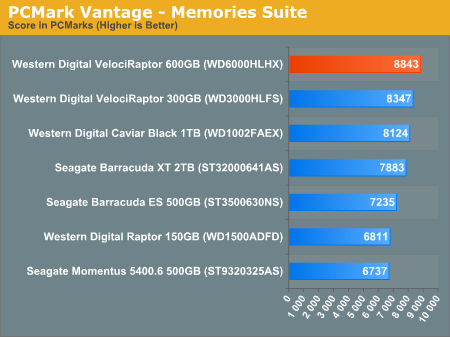
The TV and Movies tests focus on on video transcoding which is mostly CPU bound, but one of the tests involves Windows Media Center which tends to be disk bound.
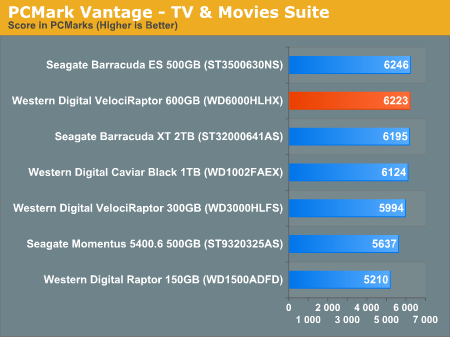
The gaming tests are effectively read tests since they spend a good portion of their time focusing on reading textures and loading level data. Actual game loading performance will differ depending on the game. Take these results as a best case scenario of what can happen, not the norm.
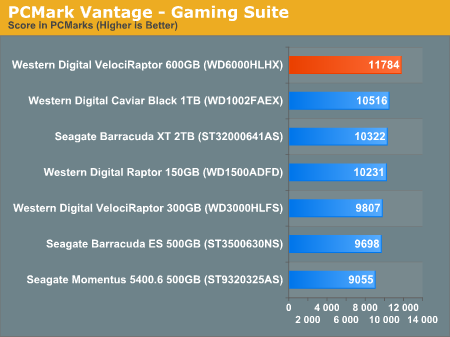
In the Music suite the main test is a multitasking scenario: the test simulates surfing the web in IE7, transcoding an audio file and adding music to Windows Media Player (the most disk intensive portion of the test).
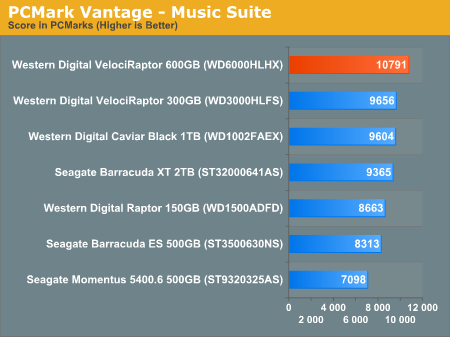
The Communications suite is made up of two tests, both involving light multitasking. The first test simulates data encryption/decryption while running message rules in Windows Mail. The second test simulates web surfing (including opening/closing tabs) in IE7, data decryption and running Windows Defender.
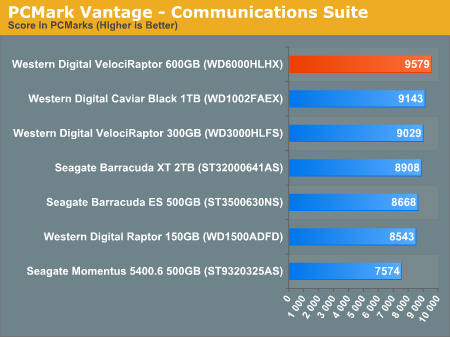
I love PCMark's Productivity test; in this test there are four tasks going on at once, searching through Windows contacts, searching through Windows Mail, browsing multiple webpages in IE7 and loading applications. This is as real world of a scenario as you get and it happens to be representative of one of the most frustrating HDD usage models - trying to do multiple things at once. There's nothing more annoying than trying to launch a simple application while you're doing other things in the background and have the load take forever.
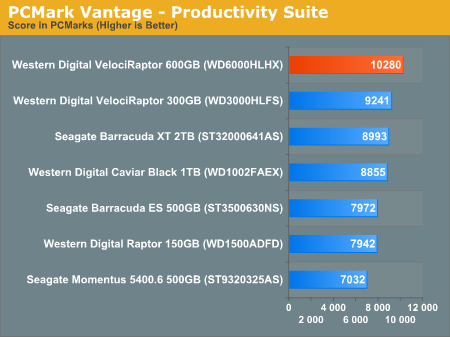
The final PCMark Vantage suite is HDD specific and this is where you'll see the biggest differences between the drives:
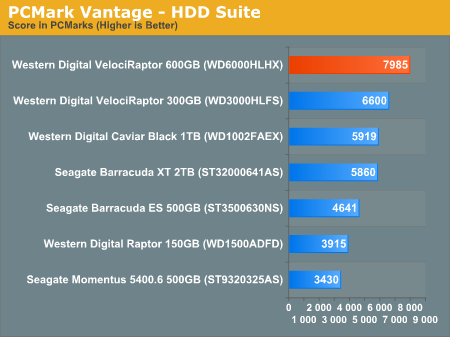










77 Comments
View All Comments
Per Hansson - Saturday, April 10, 2010 - link
I agree and would also like to see how a drive like the Cheetah 15k.7 would perform vs this VelociRaptorDen - Monday, April 12, 2010 - link
I have the (old) 150 GB raptor. What happened to make the 2.5" ones (300 and 600 both) so much noisier than the old 150? 8.5 - 9 dB(A) louder is about three times as loud!bakedalaskan - Friday, April 16, 2010 - link
Though not a price/performance issue along the lines of this article, I notice the position of the SATA connectors appear to be relocated through some kind of adapter compared to the original design 300GB VelociRaptor/ICEPAK combination. My complaint with the original 300GB drive/ICEPAK is that they don't fit in the drive tray system that I like to use on all my PC's. It appears that the new design would address standard SATA drive tray and hot swap backplane standards.dude117 - Tuesday, August 17, 2010 - link
would this make sense as a datastore for a ESX4.1 home lab to run around 20 VMs , mostly Win2003/2008, off?I would prefer a SSD drive but i am not sure how fast the drive will be dead if the VMs are constantly utilized.
Romulous - Monday, August 30, 2010 - link
I have configured several vsphere 4 servers running 8 * 300G raptors in raid 10 on a 3ware (now LSI) 9650SE controller. This configuration is very fast. (8 drives in raid 5 takes a fair performance hit though). A single drive would only work if only one operation happened at a time. This configuration would not make a serious server. It all depends on the work load you anticipate. The production servers we run for one type of VM service have 48GB ram and dual quad xeons, plus the 8 raptors in raid 10. They run over 30 VMs. File system space is the real limiting factor without a SAN.GTXRaptor - Tuesday, November 16, 2010 - link
What would really be a mind = blown moment would be a VelociRaptor SSD.Fastest SSD on the planet :).
One can dream.
crackedcoms - Thursday, January 12, 2012 - link
Learn about the latest Xrumer news today its cool and has stuff and ewrwe yeahhh